An Extensive Summary of Building Styles and Their Impact on Modern City Preparation and Advancement
Building designs have long functioned as a mirror to the social values and technological developments of their time, playing an important duty in shaping modern-day city preparation and development. From the grandeur of Neoclassicism to the utilitarian method of Brutalism, each style has presented special principles that affect metropolitan looks and performance. As contemporary obstacles emerge, consisting of sustainability and community needs, recognizing these historical structures becomes crucial. The resulting discussion not only informs future layout methods yet also increases important concerns about the equilibrium between heritage and technology in our evolving metropolitan landscapes.
Historic Review of Architectural Designs

As cultures transitioned with the Middle Ages, Gothic style emerged, identified by its verticality and detailed outlining, matching the spiritual desires of the period. The Renaissance marked a revival of classic ideals, combining art and style in cutting-edge manner ins which influenced subsequent styles across Europe.

Today, architectural styles continue to progress, driven by globalization and sustainability concerns, mirroring a vibrant interplay in between heritage and development. This historical introduction underscores the relevance of style as a mirror of societal evolution and as a stimulant for city advancement.
Trick Architectural Styles Explained
The diversity of architectural designs shows the myriad influences that shape our built environment, each symbolizing distinctive attributes and social values. Key building styles include Classical, Gothic, Baroque, Modernism, and Postmodernism, each standing for unique historic contexts and visual approaches.
Timeless style, rooted in old Greece and Rome, emphasizes balance, percentage, and making use of columns (cda architects). On the other hand, Gothic design, thriving in the center Ages, is identified by pointed arches, ribbed safes, and flying buttresses, producing a spiritual high quality in basilicas. Baroque style, emerging in the 17th century, is noted by magnificence, sophisticated ornamentation, and a dynamic interplay of light and shadow
Modernism, which got energy in the early 20th century, prioritizes feature over kind, utilizing brand-new materials like steel and glass to create minimalist structures. Postmodernism, responding against the austerity of Modernism, embraces eclecticism and historical reference, frequently integrating lively aspects and irony.

Effect On Urban Planning
In forming the advancement of cities, architectural designs dramatically affect urban planning decisions. The option of building style frequently determines the appearances, performance, and total personality of city settings.
In addition, building designs can affect zoning regulations and land utilize policies. Urban planners should take into consideration the prevailing building trends when making areas, ensuring that new growths balance with existing frameworks. This consideration cultivates cohesive city landscapes and improves community identity.
The implementation of specific architectural styles can also influence socioeconomic factors within a city. As an example, high-end contemporary layouts may bring in upscale visit here residents and companies, leading to gentrification, while a lot more budget-friendly real estate options might prioritize practical and sustainable layouts to accommodate varied populations. Eventually, the interaction between building styles and city planning produces vibrant cities that show both historic context and contemporary needs, forming the lived experiences of their citizens
Sustainability and Modern Architecture
Building styles play a pivotal role in dealing with contemporary obstacles, especially in the world of sustainability. As metropolitan locations increase and environmental problems increase, modern style significantly welcomes sustainable layout concepts that focus on energy efficiency, resource preservation, and very little environmental effect.
Contemporary building activities, such as biophilic layout and green architecture, look at this website advocate for structures that integrate with their surroundings, using natural materials and advertising biodiversity. These styles commonly incorporate sustainable energy resources, such as photovoltaic panels and wind generators, to minimize dependence on nonrenewable fuel sources and reduced carbon impacts.
Moreover, the integration of advanced technologies, such as wise building systems, enhances power monitoring, optimizing source use while making sure owner convenience. Ingenious water administration strategies, consisting of rain harvesting and greywater recycling, further contribute to sustainable metropolitan settings.
Notably, sustainability prolongs past environmental worries; it encompasses social and financial dimensions. By fostering community well-being and promoting inclusivity, modern-day architectural styles straighten with lasting advancement objectives. As a result, the advancement of building methods remains to shape resistant cities that not only satisfy the requirements of the here and now yet additionally safeguard the future for generations to find.
Community Engagement in Layout
Community interaction in layout functions as a critical bridge between engineers and the populaces they offer, making certain that the built atmosphere shows the demands and aspirations of its users. This joint procedure welcomes community participants to add their insights and choices, promoting a sense of ownership and duty towards the rooms they inhabit.
Efficient community engagement utilizes numerous techniques, such as workshops, surveys, and public online forums, to collect varied point of views. These approaches assist in a two-way dialogue, permitting architects to recognize regional contexts while empowering locals to voice their problems and wishes. This inclusivity not only enhances the style quality but likewise advertises social equity by attending to the unique obstacles faced by marginalized teams.
Furthermore, community engagement can bring about ingenious services over here that might not arise in a standard style process. By incorporating regional expertise and cultural values, engineers can produce areas that resonate more deeply with customers, enhancing use and sustainability. Ultimately, focusing on neighborhood involvement in layout procedures causes settings that nurture social communications, assistance wellness, and enhance area connections, therefore playing an essential duty fit contemporary metropolitan landscapes.
Final Thought
Architectural styles have exceptionally influenced contemporary city preparation and development, showing advancing social and technological contexts. The combination of historical aesthetics with contemporary requirements cultivates metropolitan environments that prioritize sustainability and neighborhood involvement. As cities remain to expand and adjust, the recurring dialogue between building heritage and modern layout principles will continue to be essential in creating inclusive, vivid rooms that enhance quality of life and advertise social equity. The future of metropolitan advancement rest on this unified balance.
Comments on “Elevate Your Structure Design with the Knowledge of CDA Architects”